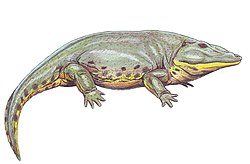| Eryopoidea | |
|---|---|
 | |
| Life restoration of Eryops megacephalus | |
| Scientific classification | |
| Domain: | Eukaryota |
| Kingdom: | Animalia |
| Phylum: | Chordata |
| Order: | † Temnospondyli |
| Suborder: | † Euskelia |
| Superfamily: | † Eryopoidea Cope, 1882 |
| Families | |
Eryopoidea is a clade of late Carboniferous and Permian temnospondyl amphibians, known from North America and Europe. Carroll (1998) includes no fewer than ten families, [1] but Yates and Warren (2000) replaced this with a cladistic approach that includes three closely related families, the Eryopidae, Parioxyidae and Zatrachydidae. [2] They define the Eryopoidea as all members of Euskelia in which the choana are relatively rounded and the iliac blade is vertical. A similar definition (without specifically naming Euskelia) is provided by Laurin and Steyer (2000). [3]

